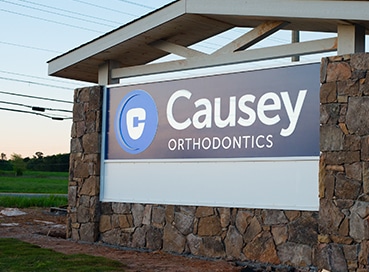The Ultimate Guide To Orthodontics
The Ultimate Guide To Orthodontics
Blog Article
Getting The Orthodontics To Work
Table of ContentsSome Of OrthodonticsThe Ultimate Guide To OrthodonticsHow Orthodontics can Save You Time, Stress, and Money.The smart Trick of Orthodontics That Nobody is DiscussingThe Ultimate Guide To Orthodontics4 Simple Techniques For OrthodonticsOur Orthodontics PDFsOrthodontics Fundamentals Explained
You might really feel some pain for some time when your dental braces are initially put on and when they are adjusted. It will certainly take a little time to obtain used to your dental braces and they can trouble your lips and cheeks. If this occurs, a relief wax can be used to your braces.It is crucial to clean your braces in addition to the front, back and eating surface areas of the teeth. Your dentist or orthodontist will provide you ideas on how to clean and on just how to floss making use of floss threaders. After flossing, roll it up in a small sphere and placed it in the rubbish.
What Does Orthodontics Do?

Issues that are not dealt with can cause the treatment to last longer. Todays dental braces are smaller sized and much less recognizable. Besides the conventional metal dental braces, there are tooth-coloured ceramic dental braces that are much less recognizable. Clear aligners are additionally readily available for adults. Dental braces and elastics can likewise be multicoloured. Speak to your dental professional or orthodontist regarding all your options.
Not known Facts About Orthodontics
It overviews the direction of tooth movement and jaw growth in somebody that is still expanding. Orthodontics. There are various sorts of headwear and they may be used during any component of the orthodontic therapy. Your orthodontist or dental professional will certainly show you how to place on the headwear and tell you the length of time to wear it each day
They may need to be worn at all times or component of the moment. Tooth elimination may be needed if your teeth are crowded or if a tooth is severely out of position. Jaw surgery (or orthognathic surgical treatment) might be needed when there are major differences in the size or position of the upper and reduced jaws.
Unknown Facts About Orthodontics
An orthodontist is a dental practitioner educated to detect, prevent, and deal with teeth and jaw irregularities. They deal with existing problems and are trained to identify troubles that may create in the future. Orthodontists deal with people of any ages, from children to grownups. People usually link a best smile with health.
All orthodontists are dental professionals, but not all dentists are orthodontists. Orthodontic residency programs use extensive, focused direction for dental specialists. They concentrate on two areas: Just how to effectively and safely move teeth Exactly how to effectively lead growth in the teeth, jaw, and faceOnce an orthodontist has completed training, they have the choice to become board accredited.
The Only Guide to Orthodontics
If you have just small malocclusion, you may be able to utilize clear dental braces, called aligners, instead of traditional dental braces. Some individuals require a headwear to help relocate teeth into line with pressure from outside the mouth. After braces or aligners, you'll need to put on a retainer. A retainer is a custom device that maintains your teeth in position.
Orthodontics for Beginners
They're most frequently utilized on kids. They can develop added space in the mouth without needing to draw teeth. Orthodontics. If you have a serious underbite or overbite, you may require orthognathic surgery (also called orthodontic surgical procedure) to extend or reduce your jaw. Orthodontists make use of cords, medical screws, or plates to sustain your jaw bone.
Throughout your first orthodontic consultation, you'll likely have: A dental examPhotos taken of your face and smileDental Homepage X-raysPanoramic (360 level) X-rays of your face and headImpressions to create molds of your teethThese examinations will help your orthodontist know exactly how to proceed with your treatment. An orthodontist is a dental practitioner who's had training to treat your teeth and jaw.
An orthodontist is focused on your bite, so something like a chipped tooth would be handled by a dental practitioner. Orthodontists are concentrated on your bite, or the way your teeth fit together, and the straightness of your teeth.
All About Orthodontics
One of the indicators of a stunning smile is a healthy and balanced set of teeth and excellent oral wellness. Many people have actually gapped, misaligned, unequal teeth that can make them imperfect.
Orthodontic treatment is recognized for its see page capability to change smiles, yet its advantages extend past mere looks. Some of these advantages are: One of the considerable orthodontic appliances is that it launches a transformative process past tooth positioning.
The Of Orthodontics
Meticulous placement reduces the propensity for teeth to move or regression post-procedure. This alignment conservation ensures that the investment in orthodontic treatment yields sustaining advantages for years. Orthodontic treatment has actually progressed substantially, supplying a spectrum of treatment methods customized to click to investigate private demands and choices. From typical dental braces to discreet clear aligners like Invisalign, clients can access diverse choices that align with their lifestyle and visual preferences.
These changes are important for keeping progression and ensuring the therapy remains on track according to the recognized strategy. The orthodontist develops a tailored treatment strategy based upon the diagnostic documents and the person's unique needs and choices. This strategy describes the recommended action to attend to the identified orthodontic problems and accomplish the desired result.
Report this page